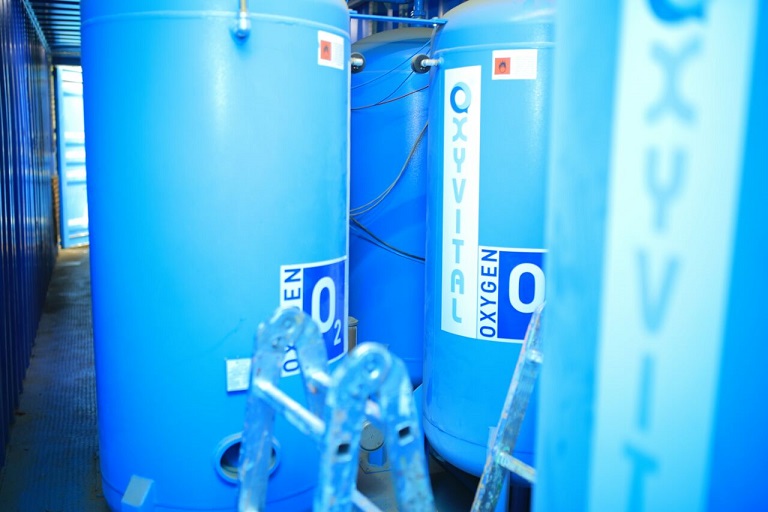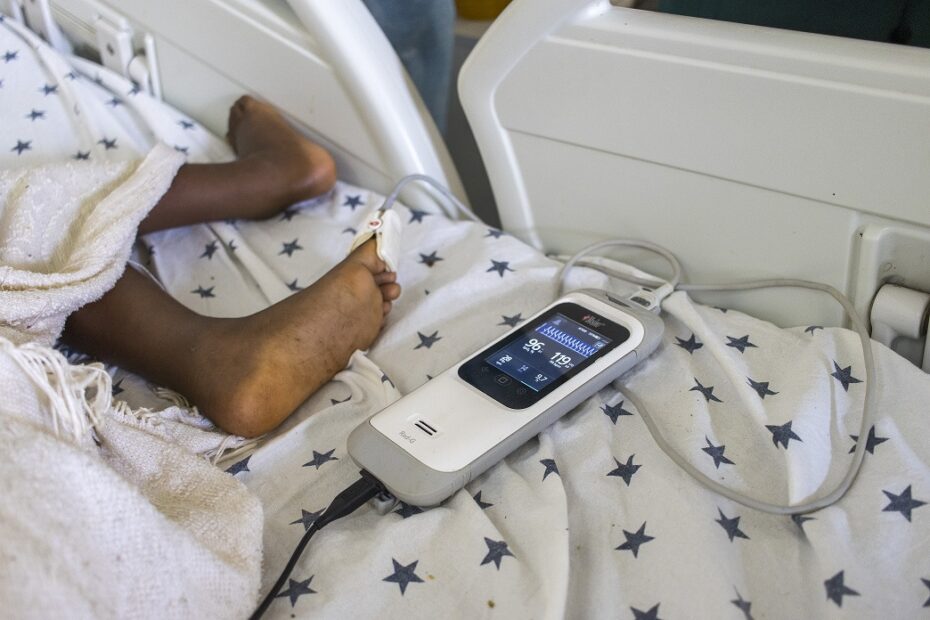Medical oxygen is an irreplaceable, essential medicine used for treating various diseases, including pneumonia, birth asphyxia, and severe malaria. It is also indispensable for the survival of mothers, children, surgical patients, and people requiring emergency and critical care.
For years, critical shortages of medical oxygen in health facilities across low- and middle-income countries were hidden. But the COVID-19 pandemic changed all that. It brought to the fore the limited supply of oxygen in many low-resourced countries. However, it was also a catalyst for over US$500 million in global investments to address oxygen-related health system challenges.
Our medical oxygen strategy
With funding from Unitaid, Bill &Melinda Gates Foundation, ELMA Philanthropies, Helmsley Trust and USAID as part of the EpiC consortium with FHI360, we have worked with 25 countries since 2020 to strengthen oxygen infrastructure within health systems.
Our oxygen work is built around five pillars to improve patient access to quality oxygen services. These are: (1) effective planning and strategies to manage oxygen systems, (2) better clinical administration and technical management of oxygen, (3) affordable, efficient, and high-quality oxygen procurement and distribution systems, (4) stronger data information systems and monitoring for oxygen access, and (5) sustainable financing for oxygen access.
CHAI’s role in expanding oxygen access
We have been able to do this work through the key roles we play as operational and strategic partners, market shapers, and ecosystem catalysts.
As a trusted strategic partner, we have helped nine countries develop roadmaps and policies to improve oxygen access and as an operational partner, support these governments to bring the maps to life. We have helped train over 7,500 healthcare workers and more than 800 biomedical engineers, ensuring the sustainable delivery of quality oxygen services and maintenance of installed infrastructure.
Moreover, as a market shaper, we have directly bolstered oxygen availability by introducing and installing 22 liquid oxygen (LOX) tanks across seven countries. To ensure their sustainable use, we have continued supplier negotiations to guarantee affordable pricing and access. Over the next few months, an additional nine countries will install up to 21 LOX tanks. As an ecosystem catalyst, we have worked alongside other partners such as PATH, UNICEF, FHI360, and USAID to sustain gains and encourage transformational impact. Since 2020, we have installed over 400 new oxygen plants and 120 LOX tanks across nine countries collectively.

PSA plant at Tikur Anbessa Specialized Hospital (TASH), Ethiopia
Ongoing challenges and available opportunities
Despite these successes, challenges with oxygen availability persist and require our collective attention. These challenges include weak maintenance structures and a shortage of trained clinical and technical staff to ensure the installed infrastructure remains functional and oxygen administered correctly. The Global Alliance for Oxygen estimates that a US$4 billion investment by 2030 is needed to increase oxygen access in low- and middle-income countries by 25 percent, potentially saving up to 860,000 lives. But data on oxygen availability and use remain sparse, making it difficult to assess where gaps remain and investment is needed.
Through close collaboration with partner governments and others in the global health space, we can close these gaps. Our work in Ethiopia, India, and South Africa illustrates how we are working with partner governments to close oxygen access gaps and strengthen the oxygen infrastructure within health systems.
Country success stories
Ethiopia: Improving oxygen access at the primary care level
The government of Ethiopia is striving to decentralize oxygen availability from higher levels to primary health facilities. One such facility in the Oromia Region is Komona Health Center, located 52 km away from the nearest town, and serving a population of 62,000, with 70 percent being under five. Patients, mostly children, must travel long distances in difficult terrain to reach the center, incurring high out-of-pocket costs for care. The government, too, incurs high costs because of the long distance, operational, and maintenance costs of running ambulances.
Komona had existing oxygen delivery equipment, but the staff did not have adequate training to use them. In collaboration with the Oromia Health Bureau, CHAI provided comprehensive training to health workers and bioengineers at the facility and orientation sessions for woreda leadership on the importance of a strong oxygen supply system. We also supported the installation of oxygen delivery devices and provided technical assistance and supportive supervision to initiate oxygen services to ensure the devices continued to work optimally. Since January 2024 when this work was done, the health center has treated 26 patients, many of whom were pneumonia cases.
Said Mohammed Ahmed, Head of Komona Health Center commented first hand on the success of this intervention: “The implementation of the oxygen ecosystem has resulted in several positive outcomes. It has enhanced access to critical oxygen therapy in our catchment area, reduced hospital referrals for oxygen therapy, and saved costs for both patients and the government. Our staff can now better monitor patient progress and witness improvements firsthand.”
A similar experience is seen in Gobeye Health Center, a location where border conflicts and instability have adversely impacted health services. At Gobeye, CHAI helped train healthcare workers and facilitated the provision and reallocation of oxygen-related equipment (pulse oximeters and concentrators). This has led to over 150 patients benefitting from oxygen service delivery, including a 3-year-old boy with severe pneumonia and dangerously low blood oxygen levels who arrived at the emergency room at midnight. Komona and Gobeye Health Center are two of over 3000 such health centers in the country.

Pulse oximeter measures baby’s oxygen level, Bonga Hospital, Ethiopia
India: Addressing hypoxemia and childhood pneumonia
CHAI-affiliate, the William J. Clinton Foundation (WJCF), has been partnering with national and state governments in India to strengthen hypoxemia (low blood oxygen) management and expand access to essential respiratory care resources since 2017.
Given pneumonia’s substantial impact (accounting for 17.5 percent) on under-5 mortality, WJCF has undertaken several targeted interventions through its pneumonia program. This support has streamlined drug and oxygen supply chains, resulting in a rise in pulse oximeter usage from 7 to 98 percent for U-5 children and an increase in oxygen administration to hypoxemic U-5 children from 55 to 95 percent between 2017 and 2022. Additionally, WJCF supported the national government in launching the “Social Awareness and Actions to Neutralize Pneumonia Successfully” (SAANS) campaign, which aims to raise awareness, mobilize communities for pneumonia protection and treatment, and strengthen public health systems, with the goal of reducing childhood pneumonia mortality to fewer than 3 deaths per 1,000 live births by 2025.
Since 2020, WJCF has continued its efforts to support the states of Chhattisgarh, Madhya Pradesh, and Punjab, to build on pandemic infrastructure gains to establish a long-term respiratory care system. This ongoing effort has led to efficient resource allocation across 111 districts and over 7500 medical oxygen technicians and healthcare workers trained on the use and management of oxygen supply and delivery systems.
South Africa: Expanding access to liquid oxygen
CHAI is a sub-grantee of FHI360 on the Meeting Targets and Maintaining Epidemic Control (EpiC) project, a global project funded by the U.S. Agency for International Development (USAID). In 2022, EpiC sought to leverage South Africa’s robust liquid oxygen landscape to expand access to medical liquid oxygen (LOX) nationally. Starting with facility assessments in up to 106 facilities, EpiC identified several access barriers which included poor quality piping systems, oversized LOX tanks, and supply-related challenges such as poor road networks and long distances to Air Separation Units. Addressing these gaps is important in making oxygen accessible and affordable. In 2023, for the first time ever, the National Department of Health, awarded the national tender for Industrial and Medical gases to two suppliers – Afrox and Air Liquide. This market shaping initiative is helping address some of these challenges due to increased competition in the South African oxygen market.
A call for collective action to ensure oxygen access
The journey toward sustainable medical oxygen access in LMICs is marked by significant progress and ongoing challenges. The collaborative efforts of organizations like CHAI, supported by various global health partners, have led to the development of comprehensive oxygen roadmaps and the installation of essential infrastructure across multiple nations. These initiatives have improved the immediate availability of oxygen and strengthened the healthcare systems that rely on it, as demonstrated by successful interventions in countries such as India, Ethiopia, and South Africa. However, despite these advancements, substantial gaps remain, including the need for continued investment in infrastructure, training for healthcare workers, and robust maintenance systems to ensure that oxygen services are both effective and sustainable. As we look ahead, it is essential for stakeholders to engage in a unified investment strategy. Progress requires ongoing collaboration, innovative approaches, and a steadfast commitment to addressing the barriers that impede equitable access to this crucial resource.





